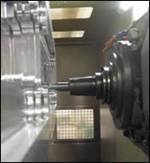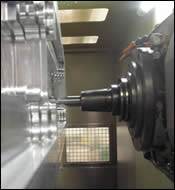High Speed Machining's Origin Moment
An important episode for high speed machining illustrates one of the most underappreciated aspects of the value of manufacturing.
If a history of “high speed machining” is ever written, it might include a moment in the late 1980s when Jerry Halley, of what was then McDonnell Douglas, heard from Ron Aarns that he was free to go ahead with the company’s development of HSM.
Mr. Halley responded, “You’re serious, aren’t you?” A fighter aircraft is maneuverable, but the process for making one doesn’t change course so easily. Winning acceptance of HSM had taken a long time. Hearing about the experience today, one of the more vital lessons that I see relates not just to Mr. Halley’s contribution, but to the significance of a role he filled at the time.
Not long ago, I had the chance to sit down with Mr. Halley and Mr. Aarns to hear their account of how a different manufacturing method found its place. Mr. Halley is now an executive vice president of Tech Manufacturing in Wright City, Missouri, but Mr. Aarns remained with the company and is an executive there. The company is now Boeing.
HSM, in this context, focuses on machining at strategic high speeds that avoid chatter by leveraging natural frequencies. (This article focuses on the same thing.) The goal of HSM to Mr. Halley was weight reduction. Components that were then produced as assemblies of sheet metal parts could instead be machined as single, lighter, monolithic pieces. In addition, through milling at stable speeds, thin ribs in these monolithic components could be milled reliably. Aircraft part designs assumed standard rib thickness greater than 0.050 inch. Thinner ribs could remove considerable weight, and Mr. Halley had seen a research report demonstrating how to mill a rib as thin as 0.013 inch.
The notion of using dramatically higher milling spindle speeds was not at all new when Mr. Halley turned to it. Dr. Scott Smith (now of the University of North Carolina—also a cofounder of BlueSwarf, mentioned in the article referenced above) was among the researchers already working on HSM at that time. The University of Florida, among other institutions, had research in this area. However, the work then tended to focus on metal removal rates. Mr. Halley found the particular applicability to aircraft weight (and therefore aircraft performance) in part because of his job function. He worked in producibility.
Part of the design group at McDonnell Douglas, “producibility” focused on how well components could be manufactured. It aimed to bridge design and manufacturing, drawing knowledge from both realms. In Mr. Halley’s case, that perspective made plain the otherwise obscure connection between chatter-free milling and improved aircraft. A person either insulated from manufacturing or absorbed with the current manufacturing processes arguably could not have seen the connection as readily—because HSM was such a departure from current processes. In fact, the extent of the departure accounted for some of the difficulty HSM faced.
Mr. Halley says HSM’s full possible impact wasn’t clear at first. In time, it became apparent that significant work then seen as sheet metal assemblies might be reconceived as milled parts. The scope of the change provided all the more reason to give serious attention to the counter-arguments—and Mr. Halley alone couldn’t champion the cause.
Fortunately, angels joined in. Mr. Aarns was one. There were others. It helped that Mr. Halley’s proposal aligned with multiple interests. Engineering wanted the weight reduction. Machining wanted the work. These groups supported him. Mr. Aarns admits that he wasn’t motivated by weight reduction as much as faster metal removal, and the cost savings that would result. This complex set of interests faced a similarly complex set of interests on the other side, and the discussion sometimes grew heated. Ultimately, HSM did go forward—and in one aircraft, 14,000 part numbers were eventually replaced by 7,000. Aircraft parts are designed for this kind of production today.
However, HSM corresponded to another developing trend—outsourcing. Manufacturing work was sent outside the company. There were real benefits to this. But there were costs, too, and one of the costs was this: With design and production no longer inhabiting the same organization, the “producibility” role lost its context. In consequence, any struggle like the one related to HSM lost a context by which it could even begin. With walls of corporate ownership built around separate disciplines, the separation arguably leaves no one well positioned to see or push the moments when manufacturing paradigms ought to change.
Mr. Halley’s current role illustrates this. He is a machining expert—his business provides machining services, and he devotes attention to making his shop’s machining processes more effective. But at Boeing, HSM was not solely a machining solution. HSM was an assembly solution, because it addressed assembly-related challenges.
I am not offering a commentary about Boeing. Boeing is, in fact, as sensitive to the value of engagement with suppliers as any large company I know. Teams within the company are committed to interfacing with suppliers—both learning from them and teaching them. The commentary instead relates to a larger view on manufacturing innovation. It seems undeniable to me that this innovation faces greater obstacles now, because innovation requires making unexpected connections between previously disconnected pieces. Such connections become more difficult when the pieces are split up among different owners. Splitting up the pieces seems to be what we’ve done almost everywhere now, throughout industry.
I don’t know how often a manufacturing innovation like high speed machining comes along. I don’t know if any such innovations have been overlooked or slowed because of a commitment to outsourcing. Even so, I think the example of HSM at Boeing/McDonnell Douglas illustrates an important point about manufacturing that we—industry at large—have yet to fully appreciate. Mr. Halley suggests machining was an assembly technology. I think the general principle is larger. What the example of shifting work away from assembly to CNC milling illustrates is that manufacturing is inherently a design technology.
Those aircraft designers, after all, were designing within constraints. The news that Mr. Halley offered was that the constraints had moved. Monolithic forms were practical. Thinner ribs were possible.
Today, if the constraints move in some similar way for the manufactured product you are involved with, will the product designers know this? Will they know how to call upon manufacturing in a fundamentally different way that leads to a better product?
In the world of product innovation, perhaps the most determinative realm of information is this: the understanding of how far reality can go. Simply put, a product design engineer could do more, if he or she had a fuller understanding of just what it is that can possibly be produced.
Related Content
How to Accelerate Robotic Deburring & Automated Material Removal
Pairing automation with air-driven motors that push cutting tool speeds up to 65,000 RPM with no duty cycle can dramatically improve throughput and improve finishing.
Read MoreYCM Alliance Hits IMTS
YCM Technology has joined with other like-minded machine tool manufacturers to take a solutions-based approach to manufacturing.
Read MoreRead Next
Applying A High Speed Machining Discipline Without The Speed
In this shop, high speed machining makes sense at 4,000 rpm. While the disciplines the shop put in place made a new 15,000-rpm profiler dramatically more productive, high speed machining would have remained valuable even if the new machine never came. Acoording to a co-owner of this shop, high speed machining has no need for speed.
Read MoreThe Cut Scene: The Finer Details of Large-Format Machining
Small details and features can have an outsized impact on large parts, such as Barbco’s collapsible utility drill head.
Read More
.jpg;width=70;height=70;mode=crop)















.png;maxWidth=300;quality=90)










